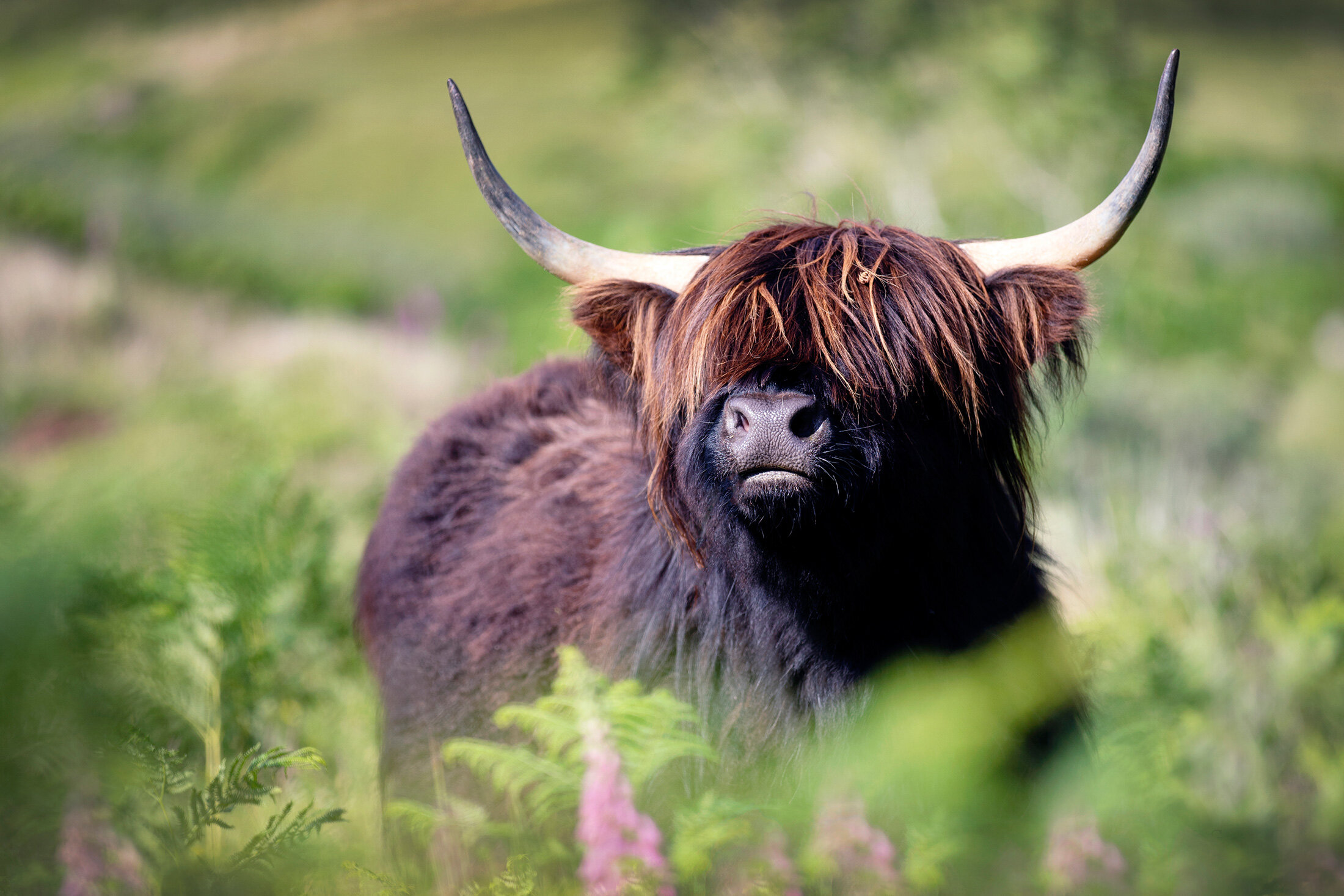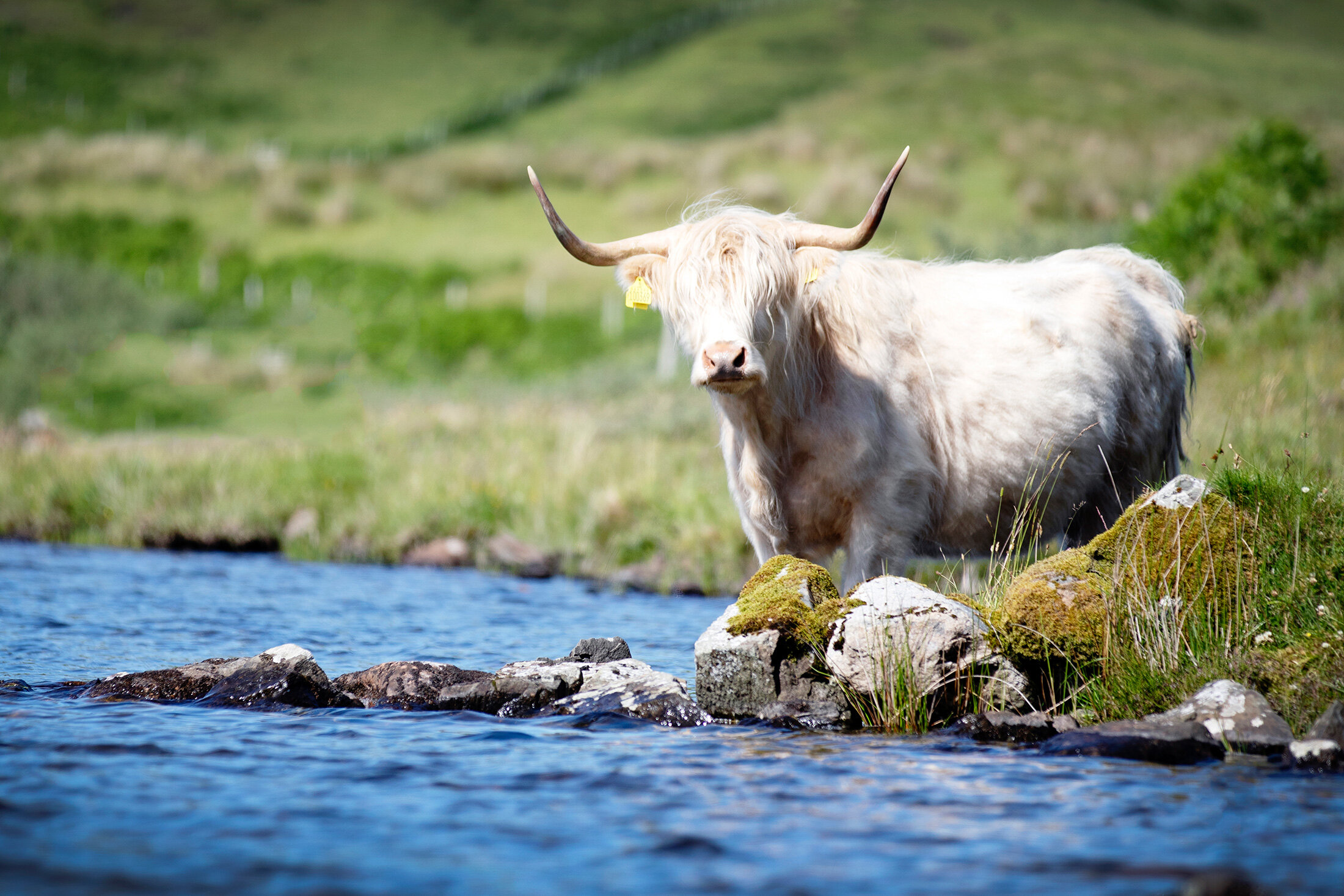
Naming your cattle the correct way
Following the female line is important. The Highland breed is primarily a female breed, because it’s the unique qualities of the female that are passed on to her progeny, especially when crossing with another breed of bull. This creates the much-desired hybrid vigour.
Getting started
When they start up a fold, many breeders have a number of females that may have been acquired from different breeders and may not be closely related. Once you start to breed with these females, heifer calves out of the foundation females are born and need to be named.
A common way to name these heifers is to use the name of the dam, thus preserving the identity of that female line. For example, let’s say a new breeder has three foundation cows from different breeders in his Delta fold: Anabladh of Alpha, Proiseag of Beta and Siusan of Gamma.
They all have heifer calves bred by him and he names them Anabladh of Delta, Proiseag of Delta and Siusan of Delta. The next year, the foundation cows have more heifer calves which might be called Anabladh 2nd of Delta, Proiseag 2nd of Delta and Siusan 2nd of Delta.
The next generation
So what happens when the daughter of Anabladh of Alpha, namely Anabladh of Delta has her first heifer calf?
Some distinction must be made to avoid confusion. Giving her another number does not necessarily help. We already have an Anabladh 2nd of Delta - she was the second heifer calf born to the original cow, Anabladh of Alpha, and her third heifer calf would be named Anabladh 3rd of Delta and so on, indicating daughters of the original Anabladh of Alpha.
Therefore, it’s quite common to alter the name in some way without losing sight of the original foundation dam. If Anabladh of Delta's first heifer calf is red in colour, she could be named Anabladh Ruadh of Delta and her second heifer calf would be Anabladh Ruadh 2nd of Delta - even although she may not be red! The line back to the first Anabladh of Alpha will still be there.
Why using only numbers can cause confusion.
Then again, consider a new breeder with three foundation cows: Anabladh of Alpha, Proiseag of Beta and Siusan of Gamma. They all have their heifer calves and he or she names them Seonaid 1st of Delta, Seonaid 2nd of Delta and Seonaid 3rd of Delta. Straight away, the obvious connection by name with the original dam is lost.
So after this, he or she can only compare cow with cow - unless they have an amazing memory for pedigrees! For example, who is the dam of Seonaid 2nd of Delta? There is nothing obvious to tell you that it’s Proiseag of Beta.
What are the siblings of Seonaid 1st, 2nd and 3rd going to be called? Following this naming system, the logical answer would be Seonaid 4th, 5th and 6th. Eventually, after the death or disposal of the three foundation cows - and if he keeps a closed herd - the breeder will end up with his complete fold all called Seonaid. That’s before we even consider the grand-daughters of Seonaid 1st, 2nd and 3rd!
Using colours for naming
Buidhe = yellow male (eg. Calum Buidhe)
Bhuidhe = yellow female (eg. Anna Bhuidhe)
Donn = brown/dun male (eg. Calum Donn)
Dhonn = brown/dun female (eg. Anna Dhonn)
Dubh = black male (eg. Calum Dubh)
Dhubh = black female (eg. Anna Dhubh)
Geal = white male (eg. Calum Geal)
Gheal = white female (eg. Anna Gheal)
Riabhach = brindle male or female (eg. Calum Riabhach and Anna Riabhach)
Ruadh = red male or female (eg. Calum Ruadh and Anna Ruadh)
Naturally, you’re entitled to name your cattle in any way you please. But the Highland Cattle Society has always been very keen to encourage the continued use of Gaelic names for Highland Cattle.
You can see a list of names alongside with translations - probably best not to attempt the pronunciation! We hope that when registering cattle, members will make use of this list particularly with regard to spellings.

Male names
Adhamh (Adam)
Agarach (Pretender)
Ailean (Alan)
Anndra (Andrew)
Aonghas (Angus)
Armann (Warrior)
Balach (Boy)
Bhaltair (Walter)
Bodach (Old man)
Bratach (Banner)
Brogach (Sturdy boy)
Cabhlaich (Admiral)
Cailean (Colin)
Caisean (Dewlap)
Calum (Malcolm)
Cathach (Warrior)
Ceannard (Chief)
Ceann-suidhe (President)
Ceann-taighe (Head of house)
Ceàrd (Tinker)
Ceatharnach (Hero)
Cìobair (Shepherd)
Cluaran (Thistle)
Coigreach (Stranger)
Coinneach (Kenneth)
Coirneal (Colonel)
Companach (Companion)
Cuairtear (Tourist)
Cubhaidh (Honour)
Cuileadair (Flatterer)
Curaidh (Hero)
Daibhidh (David)
Dòmhnall (Donald)
Donnchadh (Duncan)
Dùbhlanaiche (Challenger)
Dùghall (Dugald/Dougal)
Eachann (Hector)
Èideard (Edward)
Eilean (Island)
Eilthireach (Stranger)
Eòin (Ewan/Euan)
Fear a’ Ghlinne (Man of the glen)
Fear (Male)
Fear-bratach (Bannerman)
Fearchar (Farquhar)
Fear-cinnidh (Kinsman)
Fearghas (Fergus)
Fial (Bounty)
Fionnlagh (Finlay)
Fiuran (Hunter)
Flath (Prince/King/Chief/Hero)
Fleasgach (Youth)
Friseal (Fraser)
Fudaidh (Worthless fellow)
Gàidheal (Gael)
Gaisgeach (Hero)
Gealbhan (White one)
Gille nan Gleann (Boy of the glen)
Gille (Boy)
Gilleasbaig (Archie)
Gràidhean (Sweetheart)
Greumach (Graham)
Griogair (Grigor)
Gruagach (Long haired one)
Guag (Giddy fellow)
Guaillean (Shoulder)
Gusgarlach (Keen one)
Iain (John)
Iasgair (Fisherman)
Laochan (Little hero)
Lasgaire (Champion)
Mìcheal (Michael)
Mùillear (Miller)
Murchadh (Murdo)
Niall (Neil)
Òganach (Young one)
Oighre (Heir)
Oisean (Ossian)
Pàdraig (Peter/Patrick)
Peadar (Peter)
Pìobaire (Piper)
Prìomhaire (Prime Minister/President)
Prionnsa (Prince)
Raibeart (Robert)
Ruairidh (Roderick/Rory)
Saighdear (Soldier)
Sàirdseant (Sargeant)
Seòras (George)
Seumas (James/Hamish)
Stiùbhart (Stuart/Stewart)
Teàrlach (Charles)
Tormod (Norman)
Uachdaran (Laird)
Uibhisteach (Native of Uist)
Female names
Anna (Ann)
Bana-phrionnsa (Princess)
Banarach (Milkmaid)
Banrigh (Queen)
Barabal (Barbara)
Bean (Wife)
Beathag (Beth)
Caileag (Girl)
Cailin (Girl)
Cailleach (Old lady)
Cairistìona (Christina)
Calltainn (Hazel)
Canach (Bog cotton)
Caorann (Rowan)
Caraid (Friend)
Càraid (Twin)
Casair (Sea drift)
Catrìona (Catherine)
Ceit (Kate)
Ciorstaidh (Kirsty)
Craobhag (Small tree)
Crom-lus (Poppy)
Cruinneag (Young woman)
Dìleas (Faithful)
Dìlleachdan (Orphan)
Dìorbhail (Dorothy)
Dosan (Hair on fairhead)
Ealasaid (Elizabeth)
Eilid (Hind/deer)
Eilidh (Helen)
Èiteag (Fair maid)
Eubha (Eve)
Feàrna (Alder)
Faoilte (Delight)
Feòrag (Squirrel)
Fiochag (Little angry one)
Fionnghal (Fiona)
Flòraidh (Flora)
Frangag (Frances)
Fraoch (Heather)
Gealbhan (White one)
Gràidheag (Sweetheart)
Grìogag (Bead)
Gruagach (Young woman)
Ialainn (Honeysuckle)
Iseabail (Isobel/Ishbel)
Laochag (Little heroine)
Magaidh (Maggie)
Maighdeann (Maiden)
Mairead (Margaret)
Màiri (Mary)
Mùirneag (Cheerful girl)
Neòinean (Daisy)
Nighean (Girl)
Nìghneag (Little girl)
Oighrig (Effie)
Òstag (Hostess)
Peanaidh (Penny)
Peigi (Peggy)
Phìobaidh (Phoebe)
Pròiseag (Prude)
Raghnailt (Rachel)
Raineach (Fern)
Rìbhinn (Maiden)
Rionnag (Star)
Robag (Slut)
Ròs (Rose)
Ròsag (Rose tree)
Seamrag (Shamrock)
Seasaidh (Jessie)
Seonag (Joan)
Seònaid (Janet)
Seud (Jewel)
Seudag (Little jewel)
Sìleas (Juliet)
Sìne (Jean)
Sìneag (Little Jean)
Siùsaidh (Suzy)
Siùsan (Susan)
Sòbhrach (Primrose)
Sonasag (Happy girl)
Speachag (Venomous little creature)
Spideag (Spiteful female)
Stuamag (Modest woman)
Suairceag (Gentle one)
Sùbh-làir (Strawberry)
Tè (Female)
Uiseag (Skylark)
